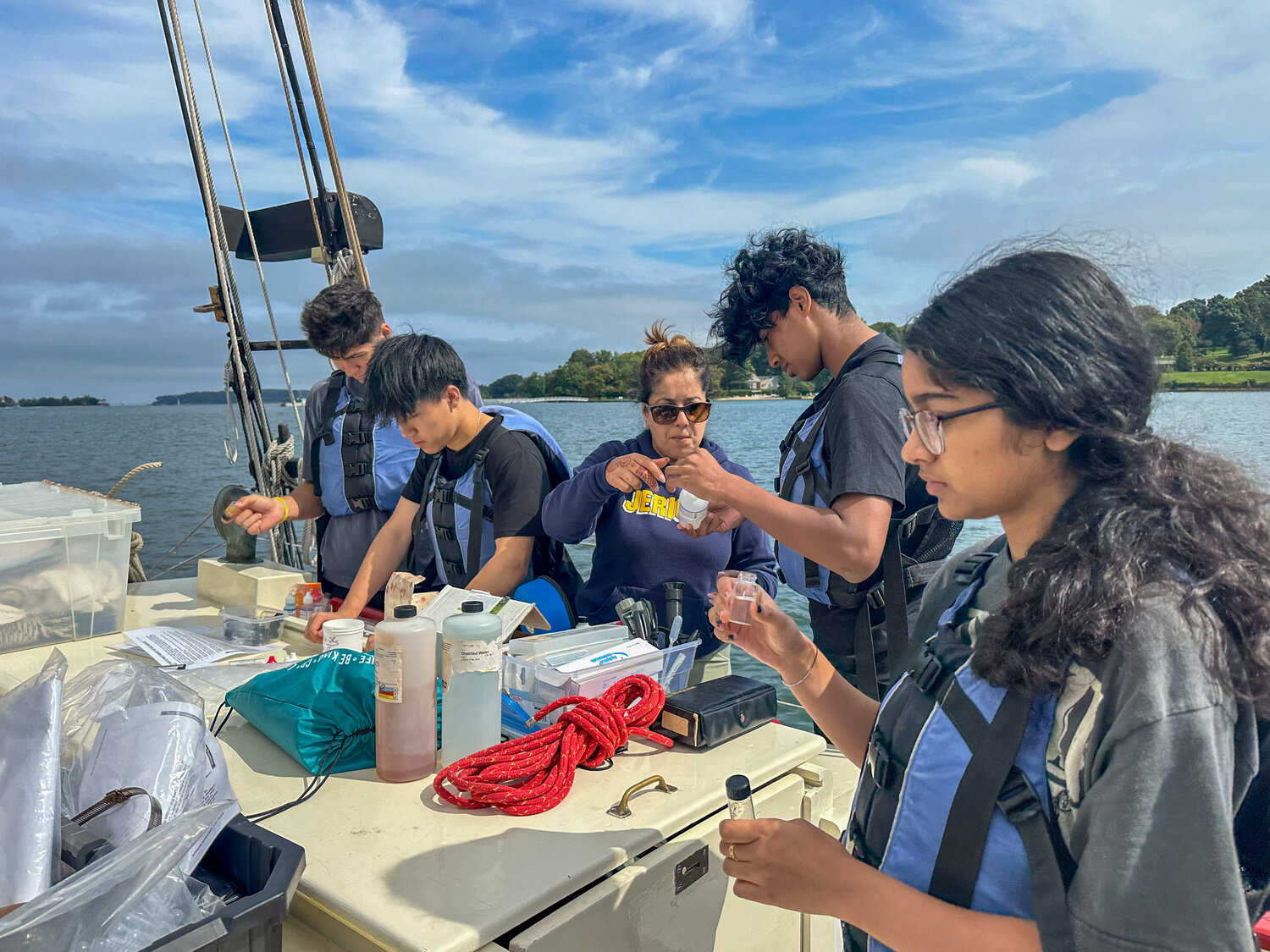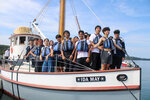Tuesday, October 1, 2024
WaterFront Center teaches students about the Sound
Jericho High School’s AP biology class recently set sail on an educational excursion at the Oyster Bay WaterFront Center, where students explored the rich biodiversity and marine ecology of the bay. The trip, which took place aboard one of the center’s historic vessels — in this case the Ida May — combined hands-on scientific activities with real-world data collection, giving the participants a unique opportunity to apply their classroom knowledge in a natural setting.
For four hours, the students rotated through a series of educational stations both on the boat and on land. Each station focused on a different aspect of marine biology and environmental science, from plankton identification to oyster growth analysis, and even water quality testing at various points in the bay. According to Shannon Kelly, the WaterFront Center’s marketing director, the program has been a highlight for Jericho’s biology students for more than a decade.
“We’ve been working with Jericho for years now, and it’s always such an exciting and enriching experience for the students,” Kelly said. “We try to make the trip as interactive as possible, allowing students to not just learn, but also engage with the environment in a meaningful way.”
One of the key activities on board was the plankton identification station, where students used a plankton tow to collect water samples from the bay. After retrieving the samples, they prepared microscope slides and identified varieties of plankton using identification sheets. The analysis gave students a close-up look at the foundation of the marine food chain.
At the oyster life cycle and growth station, students learned about the oyster’s crucial role in the local ecosystem. The center is part of the Billion Oyster Project, a New York-based initiative aimed at restoring oyster populations to improve water quality. Students measured and weighed oysters that had been growing at the WaterFront Center for nearly a year, analyzing their growth patterns and calculating mortality rates.
“We’ve been growing oysters on the dock for months, and it’s fascinating for the students to see the differences in growth and health from year to year,” Lauren Potak, the center’s head educator, explained. “Oysters play such an important ecological role by filtering water, so this activity not only teaches about biology, but also about environmental sustainability.”
Another station involved water quality testing at different locations around the bay. Using a Van Dorn bottle, students collected water samples from various depths to measure levels of nutrients like nitrates and phosphates, which are critical indicators of the bay’s health. The data was gathered from spots including Turtle Cove, the WFC mooring field and near Cold Spring Harbor, at the mouth of the Long Island Sound.
“We make sure the students understand how depth and location affect water quality,” Kelly said. “For example, nutrient levels can be different near the shore versus in deeper waters, and those differences have an impact on marine life.”
The final on-board activity involved a bottom sampler with a dredge, where students used specialized equipment to collect samples of sediment and marine life from the bay floor. Students pulled up spider crabs, sea urchins, and various species of fish and mollusks, which they examined and recorded.
After the activities on the water, students moved onto the beach to a seining station, where they gathered marine organisms using a seine net. Walking through the water with the net, they collected species like silversides, mummichugs and hermit crabs. This provided a snapshot of the bay’s biodiversity, and helped the students conduct population counts, further enhancing their understanding of marine ecosystems.
“The seining activity is always a favorite,” Potak said. “The students get to see firsthand how many different species call the bay home. It’s a fun way to teach them about population sampling and biodiversity.”
The WaterFront Center’s unique program strikes a balance between hands-on learning and academic instruction. Each station is designed to be engaging while teaching key scientific concepts that tie back to the AP biology curriculum. According to Kelly, the experience is invaluable for students, especially as they prepare for the exam.
“They’re not just reading from a textbook,” she said. “They’re out there collecting data, running tests and analyzing their results. It makes the science come alive for them, and it’s something they can carry with them into their future studies.”
Potak added that the hands-on nature of the trip helps solidify what the students are learning. “When they’re physically taking samples and recording data, it sticks with them more than just listening to a lecture,” she said. “By the time they return to the classroom, they have real-world experience that reinforces the scientific concepts.”
The students returned to school with data sheets full of observations and new insights into the health and dynamics of Oyster Bay. They planned to review the information they gathered in the classroom, where their teacher will guide them through an analysis of the results and a comparison with data from previous years.
“It’s an experience that really brings everything full circle for them,” Kelly said. “And we’re always excited to welcome them back.”
HELP SUPPORT LOCAL JOURNALISM
The worldwide pandemic has threatened many of the businesses you rely on every day, but don’t let it take away your source for local news. Now more than ever, we need your help to ensure nothing but the best in hyperlocal community journalism comes straight to you. Consider supporting the Herald with a small donation. It can be a one-time, or a monthly contribution, to help ensure we’re here through this crisis. To donate or for more information, click here.
Sponsored content
Other items that may interest you









